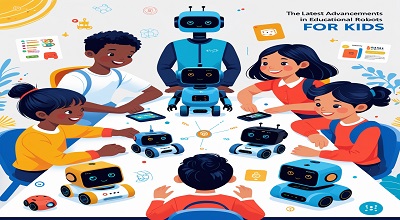Educational Robots for Kids
Educational Robots for Kids: Educational robots are interactive, programmable devices designed to enhance learning through hands-on engagement. These robots help children develop critical skills such as coding, problem-solving, and creativity while making STEM (Science, Technology, Engineering, and Mathematics) subjects more engaging.
With advancements in AI and robotics, educational robots have become more sophisticated, offering features like voice recognition, obstacle avoidance, and app-based programming. Schools, parents, and educators are increasingly adopting these tools to prepare kids for a tech-driven future.
Benefits of Educational Robots in Learning
Enhances STEM Skills
Robots introduce kids to coding, engineering, and mathematics in a fun, interactive way.
Improves Problem-Solving Abilities
Children learn logical thinking by programming robots to perform tasks.
Encourages Creativity
Many robots allow customization, fostering innovation and design thinking.
Develops Collaboration Skills
Group activities with robots promote teamwork and communication.
Makes Learning Fun
Interactive robots keep kids engaged, reducing the monotony of traditional learning methods.
Types of Educational Robots for Kids
Programmable Robots
- Controlled via block-based coding (e.g., Scratch) or text-based programming.
- Examples: LEGO Mindstorms, Sphero Bolt
AI-Powered Robots
- Use machine learning and voice recognition.
- Examples: Anki Cozmo, Miko 3
Coding Robots for Beginners
- Designed for young kids with simple drag-and-drop interfaces.
- Examples: Botley 2.0, Cubetto
STEM Robotics Kits
- Combine building and programming.
- Examples: Makeblock mBot, Robo Wunderkind
Social-Emotional Learning Robots
- Help kids develop emotional intelligence.
- Examples: Moxie Robot, Jibo
Top Educational Robots for Kids
LEGO Education SPIKE Prime
- Age Group: 10+
- Features: Combines LEGO building with Scratch/Python coding.
- Best For: Advanced robotics and engineering projects.
Sphero BOLT
- Age Group: 8+
- Features: Programmable LED matrix, obstacle detection.
- Best For: Coding and interactive games.
Anki Cozmo
- Age Group: 6+
- Features: AI-powered, facial recognition, games.
- Best For: AI and robotics introduction.
Makeblock mBot Neo
- Age Group: 8+
- Features: Wi-Fi enabled, supports Python coding.
- Best For: School robotics programs.
Miko 3
- Age Group: 5-10
- Features: Conversational AI, educational games.
- Best For: Emotional and cognitive development.
How to Choose the Right Educational Robot for Your Child
Consider Age and Skill Level
- Ages 4-6: Simple coding robots (Botley, Cubetto).
- Ages 7-12: Intermediate robots (Sphero, mBot).
- Ages 13+: Advanced kits (LEGO Mindstorms, Raspberry Pi robots).
Check Compatibility
- Does it work with tablets, PCs, or smartphones?
Evaluate Educational Value
- Does it teach coding, engineering, or AI concepts?
Budget Considerations
- Prices range from 50to50to500+.
Read Reviews & Recommendations
- Look for feedback from educators and parents.
Integrating Educational Robots in School Curriculums
Many schools now include robotics in STEM programs. Benefits include:
- Hands-on learning experiences.
- Preparing students for future tech careers.
- Encouraging teamwork through group projects.
Future Trends in Educational Robotics
- AI & Machine Learning Integration: More adaptive learning robots.
- Augmented Reality (AR) Robots: Interactive 3D learning.
- Affordable Robotics Kits: Wider accessibility.
- Emotion-Sensing Robots: Better social-emotional learning.
Challenges and Considerations
- High Costs: Some advanced robots are expensive.
- Teacher Training: Educators need proper training.
- Screen Time Concerns: Balancing digital and physical learning.
Conclusion
Educational robots are revolutionizing learning by making STEM subjects interactive and fun. With options ranging from beginner-friendly bots to advanced AI robots, there’s a perfect fit for every child. As technology evolves, these tools will play an even bigger role in shaping future innovators.
FAQs
Q1: What is the best educational robot for a 5-year-old?
A: Botley 2.0 or Cubetto, as they offer screen-free coding.
Q2: Are educational robots worth the investment?
A: Yes, they enhance STEM skills and critical thinking.
Q3: Can educational robots help with coding?
A: Absolutely! Many teach block-based and text-based coding.
Q4: How do I maintain an educational robot?
A: Follow manufacturer guidelines, keep software updated, and store properly.
Q5: Are there free coding apps for robot programming?
A: Yes, Scratch and Sphero Edu offer free coding platforms.
Free Download: Tapmap App HBL PSL 2025
